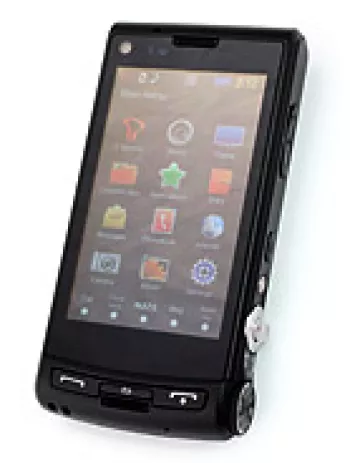
Overview of Samsung I7500 Galaxy
The Samsung I7500 Galaxy, released in June 2009, marked Samsung's foray into the Android smartphone market. This device stands out as one of the first to feature the Android 1.5 Cupcake OS, showcasing a blend of powerful new technology and user-friendly software for its time.
Network Capabilities
The Samsung I7500 supports GSM and HSPA technology, making it compatible with a broad range of network bands. Specifically, it operates on 2G bands GSM 850 / 900 / 1800 / 1900 and 3G bands HSDPA 900 / 1700 / 2100, offering HSPA speeds of up to 7.2 Mbps. This ensured that users could enjoy reliable connectivity, whether for voice calls or data usage.
Design and Build
Elegantly crafted, the device measures 115.9 x 56 x 11.9 mm and weighs just 116.7 grams. The compact design accompanied by its Mini-SIM capability contributes to its ease of handling and portability. Furthermore, the availability in classic Black and White colors gives users some aesthetic customization options.
Display Characteristics
The 3.2-inch AMOLED display offers vibrant color reproduction with its effective 65K colors. Boasting a resolution of 320 x 480 pixels at a 3:2 ratio, the screen has a pixel density of approximately 180 ppi. Though not the largest by today’s standards, the screen was a highlight in usability and media consumption at the time.
Operating Platform
Running on Android 1.5 Cupcake, the I7500 Galaxy provides users the opportunity to experience early versions of the Android ecosystem. The Qualcomm MSM7200A chipset, supported by a 528 MHz ARM 11 CPU and an Adreno 130 GPU, ensures the device operates smoothly for general tasks, albeit with limitations on multi-tasking due to the hardware specifications.
Memory and Storage
Internally, the I7500 contains 8GB of storage alongside 128MB of RAM. While the RAM amount limits extensive multitasking, the storage can be expanded thanks to the dedicated microSDHC slot, fostering a capacity for additional apps and multimedia files.
Camera Features
The main camera, a 5 MP autofocus with an LED flash, provides reasonable photography capabilities for the time of release. Although it lacks advanced features seen in contemporary models, it was sufficient for casual photography needs, supporting basic video recording functionalities.
Audio and Connectivity
On the audio front, the Samsung I7500 is equipped with a loudspeaker and a 3.5mm audio jack, allowing for personal enjoyment of media. For connectivity, Wi-Fi 802.11 b/g enables internet access in wireless networks, while Bluetooth 2.0, albeit limited to headset support, facilitates short-range data transfer. The inclusion of GPS enhances navigational functionalities, though the absence of a built-in radio might be seen as a shortcoming for radio enthusiasts.
Sensors and Other Features
The device is equipped with sensors such as an accelerometer and a compass, broadening its applicability for different contexts and software functions. Web browsing is supported through an HTML browser, albeit likely to feel slow by modern performance standards.
Battery Performance
Powering the I7500 Galaxy is a removable Li-Ion 1500 mAh battery. The device promises a standby time of up to 450 hours on 2G networks and up to 340 hours on 3G networks. Users could also benefit from a respectable talk time of up to 9 hours and 20 minutes on 2G and up to 6 hours and 10 minutes on 3G.
Market Status and Pricing
Upon release, the Samsung I7500 was priced at approximately 140 EUR, making it a compelling purchase option for early adopters of Android smartphones. Today, the device is discontinued, but it still holds nostalgic value for technology enthusiasts and collectors.
Performance and User Experience
Considering its early placement in the smartphone market, the Samsung I7500 offered strong performance within its capacity. Testing showed the camera could produce decent photos, and the loudspeaker provided fair audio levels. The user experience, while basic compared to today's standards, paved the way for subsequent Galaxy devices that pushed the envelope further.
Conclusion
The Samsung I7500 Galaxy serves as a historic artifact in the evolution of smartphones. Introducing many to the Android operating system, it laid the groundwork for Samsung's future successes in the mobile world. While modern devices have drastically improved in every area, the I7500 remains a testament to the rapid evolution of mobile technology.
Key Features of Samsung I7500 Galaxy
- AMOLED Display: 3.2 inches with 320 x 480 pixels resolution
- 5 MP Main Camera with LED flash
- Internal Memory: 8GB storage with 128MB RAM, expandable via microSDHC
- Android OS: Version 1.5 (Cupcake)
- Processor: 528 MHz ARM 11
- Wi-Fi 802.11 b/g connectivity
- GPS for positioning
- 3.5mm headphone jack
- Removable Li-Ion 1500 mAh battery with up to 9 hours and 20 minutes talk time (2G)
- Compact Dimensions: 115.9 x 56 x 11.9 mm
- Lightweight: 116.7 g
- Sensors: Accelerometer and compass
- Supports GSM / HSPA networks
Drawbacks of Samsung I7500 Galaxy
- Uses outdated Android 1.5 (Cupcake) OS which lacks modern app compatibility and features.
- Limited internal memory of 128MB RAM, leading to slower performance especially with multitasking.
- Screen size of 3.2 inches with a low resolution of 320x480 pixels (~180 ppi), providing a less vibrant display experience.
- Lacks a front-facing selfie camera, limiting video calling capabilities.
- No FM Radio feature available for entertainment on-the-go.
- Bluetooth version 2.0 only supports headset, limiting connectivity with newer devices.
- Discontinued status, meaning no official updates or support from the manufacturer.
- Released in 2009, which makes it technologically outdated compared to modern smartphones.

















View Also
More Phones
All Rights Reserved +14266 Phones © Mobilawy 2025

























